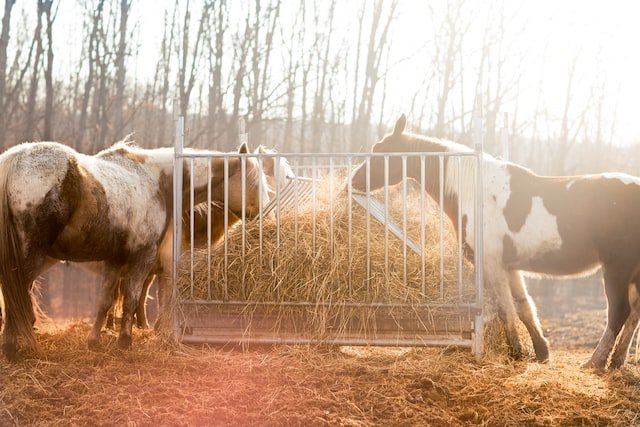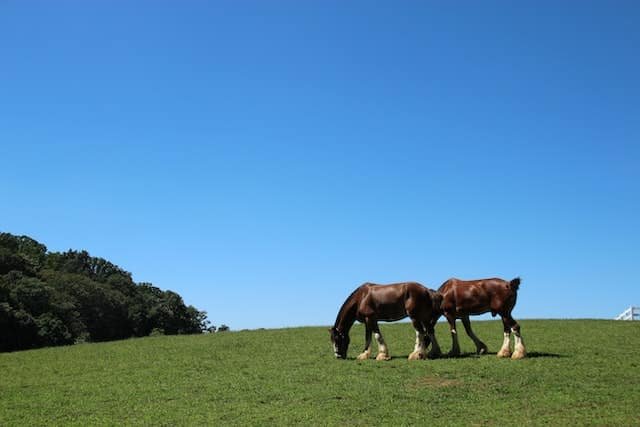Why do horses eat hay? Horses eat hay for three main reasons. First, they have evolved over millions of years to be able to survive in grasslands. So grass and hay are natural foods for a horse.
Along the evolutionary path, their bodies including jaws and teeth as well as digestive systems adapted to grazing and digesting grass.
Consequently, a horse can extract most of its needed nutrition from grass or hay to supply itself with the energy it needs.
Let’s now look at each of these points in detail. We will also review a horse’s nutritional needs, the use of concentrates as supplements, and natural alternatives to hay for extra roughage.
Let’s dive in.
Why Do Horses Eat Hay: Evolution and Diet
As horses have evolved over the past 60 million years, from their earliest ancestor, the Eohippus, to the modern horse, the Equus Caballus, they have adapted to an ever-changing environment, climate, and diet.
The Eohippus was a small, forest-dwelling creature, eating leaves, fruits, and nuts. But as the climate changed and the forests receded, they were forced to adapt to the emergence of grasslands. And so they did – evolving into larger creatures with long necks and legs that could reach the grasses, and bodies designed to digest them.
The modern horse is the product of this millennia-long evolutionary process. And as it went through these adaptations the horse’s body changed to make it easier to digest grasses and extract their nutrients.
The horse’s teeth adapted to better grind down the tough grasses. The meadow fescue, for example, has evolved to be tough and fibrous to protect itself from being eaten. But the horse’s teeth can grind it down. The horse’s digestive system also evolved to extract more nutrients from plants and this is why horses eat grass.
Let’s study this some more.
Jaws, Teeth and Digestive Systems: Made for Vegetation
The horse’s jaws are specially adapted to grinding down vegetation. The front teeth, the incisors, are used for nipping off grasses. The molars at the back of the mouth are for grinding down the tough vegetation.
The horse has three incisors, 3 premolars, and 3 molars (in adult horses only) on each side, and the upper teeth and the lower teeth are mirror images of each other. As you can imagine, this construct of the jaws and teeth is ideal for cutting, chewing and grinding grass, hay, and vegetation.
The horse’s digestive system too, is primed for a diet of plants. The stomach is small and the intestines are very long. This way the food passes quickly from the stomach to the small intestine for digestion.

Since horses are herbivores they consume plenty of fiber or cellulose. This cellulose is broken down by bacteria in the colon through a process called hindgut fermentation.
The hindgut fermentation process is seen in monogastric herbivores (like horses and rabbits) and it allows them to extract more energy from plants than other grazing animals like cows (which are ruminant herbivores).
So as you can see the horse’s anatomy including jaws, teeth, and digestion systems are made for processing hay and so instinctively this makes the horse want to eat hay.
Understanding A Horse’s Nutritional Needs
As with most animals, a balanced diet for a horse needs to include protein, carbohydrates, fat, minerals and water. Believe it or not, many of these needs can be met by grass or hay.
During the summer when they graze, horses get enough protein from the grass. But every horse’s needs are different. If your horse needs more protein you can supplement its diet with other feeds like soybean or alfalfa. You may also have to do this in winter if where you live grazing in winter is not an option.
Grass and hay, naturally, have plenty of carbohydrates but for horses that do work or exert a lot, this may not be enough. It might be better to also give them cereals like oats or barley.
As for fat, hay has very low fat content and you may need to supplement your horse’s diet with fats especially those from vegetable oil. For these, you could consider supplements which we will discuss in the next section.
Horses can get water from grass in the spring which contains water but it’s best for the horse to have a clean water source. And for minerals, either soya bean or alfalfa feeds (which are also good sources of protein as we’ve seen) or a good quality salt block will provide what the horse needs.
Dietary Supplementary to Hay
Dietary supplements can be either in the form of commercial mixes or naturally occurring foods. Commercial mixes are made from different ingredients and have different nutritional values from each other but can all add variety to your horse’s diet.
Commercial Feeds can be made from oats, barley, sugar beet, bran, alfalfa, etc. Note that different feeds have different benefits so choose the one that will benefit your horse the most. Also, different feeds have different densities and so weigh differently from each other. So when selecting one over the other and using a measure to feed your horse be careful and make sure that you aren’t overfeeding or underfeeding.
Natural supplements include fruit, carrots, or even oils that can be added to the feed. And, as we saw in the previous section, a block of salt can be made available to the horse so that it can take a lick whenever it feels like it.
Good Hay, Bad Hay and Alternatives for Extra Roughage
Finally, when we ask ourselves – why do horses eat hay? – the conversation will not be complete without discussing the quality of the hay. As with all products, there are different grades and qualities of hay.
Good hay is dry, has a fresh smell, is green in color, and is free from dust, mold, and chemicals. It should also be soft to the touch. If you can get hold of hay that fits this description then your horse will be very happy.
Bad hay, on the other hand, is dry and crumbly, has a musty smell, is brown or yellow in color, and can be dusty, moldy, and/or include chemicals. This type of hay should be avoided as it can cause health problems for your horse.
There are also alternatives to hay that you could consider if you can’t get hold of good hay or if you want to give your horse some variety in its diet. These include haylage (a type of silage made from grass), straw, and chaff.
The Bottom Line
So, why do horses eat hay? The primary reason is that their evolution has ensured they are made to eat grass, hay and vegetation. Their jaws and teeth are specially adapted for this kind of diet as is their digestive system. And horses extract enough nutrients from grass and hay needed to lead healthy, active lives.
Like humans, horses too need a balanced diet that consists of carbohydrates, proteins, fats, water, and minerals. While hay provides carbohydrates and some protein, it sometimes lacks in other nutrients. This is why it is important to supplement your horse’s diet with supplementary feeds and additional sources of roughage.



